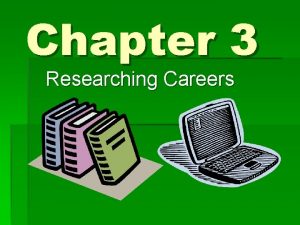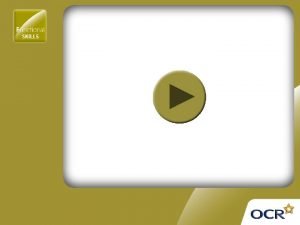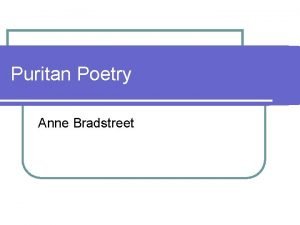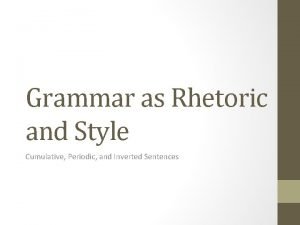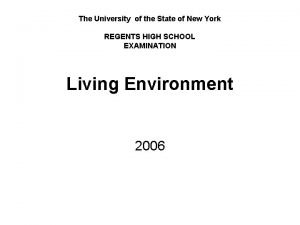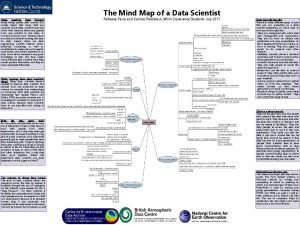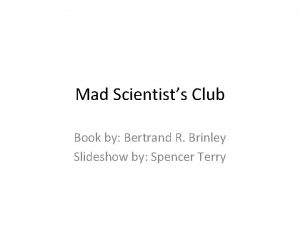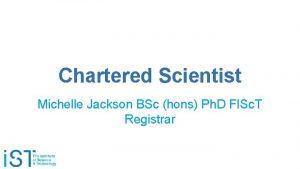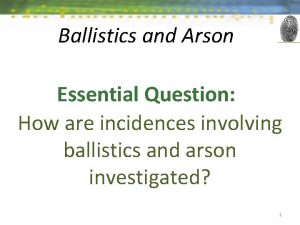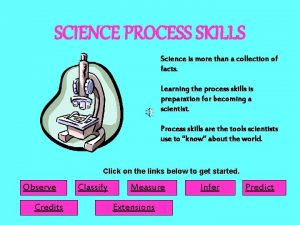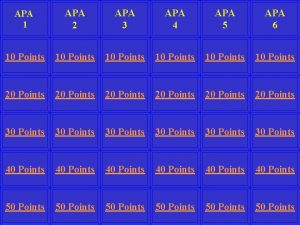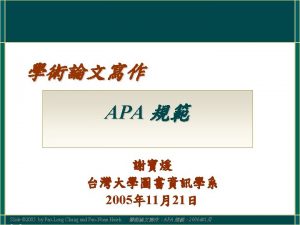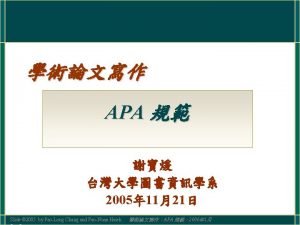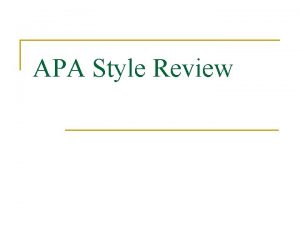Researching Like a Scientist Using APA Style What



































- Slides: 35

Researching Like a Scientist Using APA Style

What is APA Style? APA (American Psychological Association) Style originated in 1929, when a group of scientists convened to create a set of procedures, or style rules, that would make reading/writing scientific papers easier.

Who Uses APA Style? • All science classes • Other fields are adopting APA style

Why Use APA Format? • Provides consistent format • Allows readers to easily find & verify your sources • Gives you credibility as a writer • Protects you from plagiarism

Avoiding Plagiarism • What is plagiarism? • using someone else’s words or ideas as if they were your own • stealing

Avoiding Plagiarism • Consequences of plagiarism: • • • Fail a paper/project Fail a course Expulsion from school Lawsuits Fines Jail time • Proper citation of your sources in APA style can help you avoid plagiarism

Selecting Sources Good sources are: • Scholarly • author works in field they write about • Author is respected in their field • Author cites sources • Peer-reviewed • The source is vetted by other scientists in the field • Credible • Is there an obvious slant to the information? • Does it have an author’s name & citations? • Age sensitive • sources are generally no more than 5 years old for scientific research

What are good sources? • • Peer-reviewed scientific journals Current library books Magazines & newspapers (sometimes) GALILEO is the best source! • For home access: www. galileo. usg. edu • Password: puddle

General Rules for APA Style • 1” margins on all sides • 12 pt. font • Times New Roman font or Courier font • Double-space • Indent the first line of each paragraph • Include page number & running head on all pages

Main Parts of an APA Paper • • Title page Abstract Introduction Methods Results Discussion References Makes up the BODY of your paper

Title Page • Title page counts as page 1! • Include the paper’s full title, your name & school’s name centered on top half of page. • Your teacher may require additional info on the title page such as date or class period. • The running head should appear on each page of your paper--even page 1—and it includes short version of title (ALL CAPS) & page number • NOTE: on page 1 only the shortened title is preceded by “Running head: ”

Title Page

Abstract • A brief summary of the paper • Quickly shows reader the main points of your paper • Summarizing each section of your paper is an easy way to create your abstract • Don’t indent the beginning of the abstract paragraph • Page is titled “Abstract” & title is centered

Abstract

Introduction • Begins on page 3 of your paper & begins the body of your paper • Type the full title of your paper (centered) on the first line & begin your intro on the next line • Usually the first few paragraphs of your paper • Presents the problem and main ideas that the paper addresses • State your hypothesis here • Give background info on your topic

Introduction

Method • Detailed explanation of HOW you did your research • Usually contains the following subsections: • Participants: who or what is in your study? • Research Design: variables, controls, blind studies? • Measures: tests or instruments you used to collect data • Procedures: describe each step of your experiment in great detail

Results • This is the area where you describe the results of your research • Don’t interpret results here, just give the facts • You should state whether your hypothesis was supported by the research—just don’t try to explain why in this section

Discussion • This is where you explain why your hypothesis was/wasn’t supported by the research • Were the results what you predicted? • How do your results compare to the rest of the research on this topic?

Method, Results & Discussion • Headings for these sections are bold and centered Method • Headings for any sub-sections (participants, research design, measures & procedure) are bold and left justified Participants

Method, Results & Discussion

References • A list of ALL sources that you get information from. • Provides the information necessary for a reader to locate and retrieve any sources cited in your paper. • Sources are alphabetical by author’s last name • Page is titled “References” and title is centered • Use hanging indent for each new source

References

References: Some Examples • Book Coleman, L. (2010). Researching like a pro: apa style. Atlanta, Ga: Rampage Publications. • Article from database Goffman, E. (2010). Running on algae. E - The Environmental Magazine, 21(1), 15 -33. Retrieved from Environment Complete database. • Article from print journal Jacoby, W. G. (1994). Public attitudes toward GMOs. American Journal of Science, 38(2), 336 -361.

Citation Creation Resources • Citation Machine • ww. citationmachine. net • Easy. Bib • www. easybib. com • School subscription allows extra features like APA style, digital notecards, and more!

Parenthetical Citations • In-text citation • Crediting your sources where you use their info in the body of your paper • Used when you paraphrase or quote another person in your paper

Parenthetical Citations • Paraphrasing a source. To use an idea from another source but put it in your own words. • Quoting a source. To repeat another source word for word using quotation marks.

Quote “The study clearly shows that National Football League physicians adopted a more conservative approach to concussion management in the second six-year period of the study’s 12 year examination of concussions of NFL players. ” vs. Paraphrase NFL doctors were more cautious in their treatment of concussed NFL players in the second half of the study.

Parenthetical Citation Examples • Author’s last name and publication year must appear in the parenthetical citation. • Kessler (2003) found that among epidemiological samples… • Researchers found that early onset results in a more persistent and severe case (Kessler, 2003). • In 2003, Kessler’s study of epidemiological samples showed that…

Parenthetical Citation - Quotes • When QUOTING you must include the page number, as well as the author’s name and publication year. • Rogers (1961) once wrote that two important elements of a helping relationship are “genuineness and transparency” (p. 37). • Punctuation is always outside the parenthesis.

Block Quotes • If your quote is more than 40 words, you should • • • create a block quote Quote begins on new line Place a colon at the end of your regular text and begin the block quote on the next line Entire quote is offset 1 tab No quotation marks Parenthetical citation goes OUTSIDE the closing punctuation mark

Block Quotes

Where can you go for additional help with the APA style? �Publication Manual of the American Psychological Association, 6 th ed. �Official APA website: http: //www. apastyle. org/ �Purdue University OWL (Online Writing Lab) http: //owl. english. purdue. edu/ �Mrs. Coleman in the Learning Commons https: //newton. instructure. com/courses/16

Galileo • www. galileo. usg. edu • Password: puddle (Check Canvas for updates)

My Sources • American Psychological Association. (2010, February). Basics of the apa style tutorial. Retrieved from http: //flash 1 r. apa. org/apastyle/basics/index. htm • Jeffrey Kahn. (2009). Sample apa paper for students interested in learning apa style 6 th edition. Retrieved from http: //my. ilstu. edu/~jhkahn/APAsample. pdf • Purdue Online Writing Lab. (2008). Apa formatting and style guide. Retrieved from http: //owl. english. purdue. edu/owl/resource/560/01/ • Larrimore, A. (2016, August 18). APA Style [Telephone interview].
 Chapter 3 researching careers
Chapter 3 researching careers Researching wan technologies
Researching wan technologies Researching
Researching Jana mittermaier
Jana mittermaier Think like a citizen scientist journey requirements
Think like a citizen scientist journey requirements Modified block style with mixed punctuation
Modified block style with mixed punctuation Formal writing vs informal writing
Formal writing vs informal writing What is an informal style
What is an informal style Referential style vs. expressive style
Referential style vs. expressive style Example of puritan plain style
Example of puritan plain style Cumulative sentence
Cumulative sentence Image style transfer using convolutional neural networks
Image style transfer using convolutional neural networks Food scientists measure food energy in:
Food scientists measure food energy in: Data scientist ausbildung wien
Data scientist ausbildung wien Things a computer scientist rarely talks about
Things a computer scientist rarely talks about The diagram below shows how a coverslip should be lowered
The diagram below shows how a coverslip should be lowered Making of a scientist mind map
Making of a scientist mind map Far side rocket scientist
Far side rocket scientist Nih staff scientist
Nih staff scientist Si derived unit of pressure scientist
Si derived unit of pressure scientist Mad scientist club book
Mad scientist club book Penjual sebagai artis dan scientist
Penjual sebagai artis dan scientist Forensic is derived from the latin word
Forensic is derived from the latin word What makes a scientist
What makes a scientist Chartered scientist
Chartered scientist Herbalife mark hughes
Herbalife mark hughes Burned fire scientist questions arson
Burned fire scientist questions arson Avogadro scientist
Avogadro scientist Certificated natural scientist
Certificated natural scientist Chief scientist scotland
Chief scientist scotland World bank data scientist
World bank data scientist Forensic science jobs
Forensic science jobs Famous english scientists
Famous english scientists Quantum mechanical model scientist
Quantum mechanical model scientist Paragraph on scientist
Paragraph on scientist Paragraph on scientist
Paragraph on scientist
